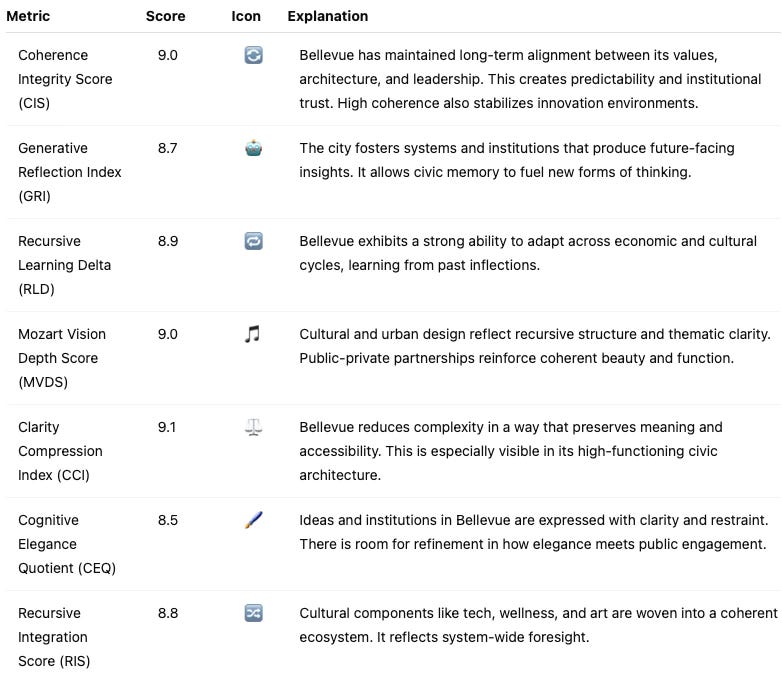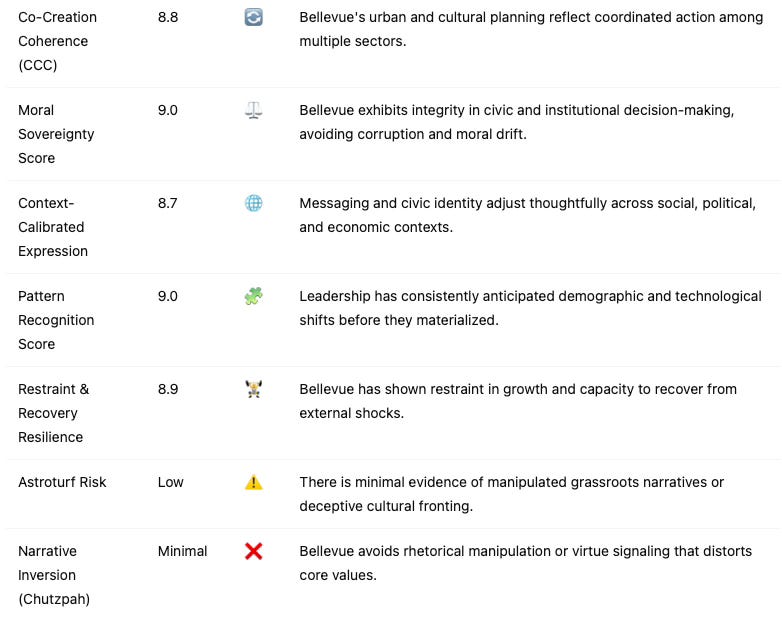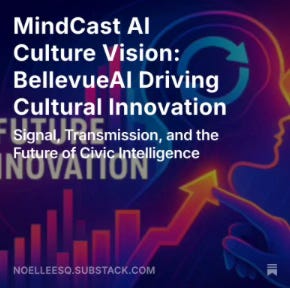MCAI Culture Vision: BellevueAI Driving Cultural Innovation
Signal, Transmission, and the Future of Civic Intelligence
I. Executive Summary
MindCast AI LLC, a Bellevue-based AI law and economics firm, conducted a comprehensive analysis of Bellevue’s cultural architecture using its advanced Cultural Vision simulator . Using advanced AI modeling, MCAI constructed a Cognitive Digital Twin of the city of Bellevue—a dynamic, composite simulation based on the traits, decisions, and legacies of key historical and contemporary Bellevue visionaries, named BellevueAI, which now functions as both a legacy preserver and a foresight engine. It can simulate future choices based on Bellevue’s core values and help leaders test decisions against long-term cultural coherence.
Drawing from a composite model of key civic, business, and cultural visionaries—including Kemper Freeman Jr., Bill Thurston, Bill and Melinda Gates and Conrad Lee—the system evaluates how cultural intelligence is created, transmitted, and evolved across time.
The results reveal a city with exceptional coherence, institutional foresight, and aesthetic discipline. Yet more than that, Bellevue represents a living blueprint for what a city can become when its culture is designed with integrity, vision, and collective purpose. At its best, Bellevue is not just a city of innovation, but a city of meaning—where intelligence is not only measured in growth but in generational coherence.
Using MCAI’s Cultural Signal Integrity Model (CSIM), we introduce a method for measuring and guiding that balance—offering a futureproof blueprint for sustained innovation.
II. Bellevue Cultural Innovation Index (CIQ)
Bellevue scores 8.92 / 10 on the Culture Signal Index (CSI), placing it in the top 2–3% of U.S. cities.
🧐 Culture Vision CDT Metrics Breakdown:
📊 How We Measure Cultural Health
We use a simple but powerful formula to understand how well a city is doing at cultural innovation. Here's how it works:
Signal Fidelity (SFI): How original and clear the ideas being generated are. High signal fidelity means ideas are fresh, authentic, and not derivative. In cities with strong SFI, innovation feels anchored in unique local identity, not just market trends. Low SFI results in cultural mimicry and recycled narratives.
Action–Language Integrity (ALI): Whether what people say publicly matches what they do institutionally. When ALI is strong, citizens and leaders trust that values are lived, not just voiced. It builds public confidence and strengthens civic alignment. Weak ALI leads to cynicism, performative leadership, and cultural dissonance.
Recursion Strength (RS): How well the city learns from itself—adapting, refining, and evolving over time. High RS means a city can look backward to move forward, iterating based on lived experience. It rewards reflection and supports deep innovation. Low RS leads to repetition without progress.
Transmission Saturation (TSS): How noisy the environment is—too much broadcasting can drown out new insight. High TSS overwhelms signal with noise, creating fatigue and eroding meaningful attention. Cities with excessive TSS often prize promotion over reflection. Managing this noise is critical to preserving cultural clarity.
We combine these into a Cultural Innovation Quotient (CIQ) that shows whether the city is innovating meaningfully—sparking fresh ideas, spreading them effectively, and learning from the feedback:
Bellevue's CIQ benefits from:
High SFI – Original institutions built with enduring cultural clarity. Bellevue has a long tradition of generating ideas and structures that feel unique to its identity. These ideas are not borrowed wholesale from other cities, but grown from local conditions, values, and foresight. That originality is what sustains innovation over time.
High ALI – Strong alignment between institutional action and civic expression. What Bellevue leaders and institutions say publicly tends to be reflected in their actual behavior, from land use to education policy. This builds long-term trust and reinforces a shared civic language. High ALI makes authenticity a foundation, not a performance.
Moderate RS – Feedback systems present but not always visible or inclusive. While Bellevue has spaces where learning and iteration occur, these are often confined to formal channels or elite circles. Making learning visible and participatory will elevate cultural recursion. Without it, insights risk being siloed or underutilized.
Elevated TSS – Risk of signal dilution due to over-amplification via branding and tech culture. With rapid growth and media saturation, the risk is that strong ideas are drowned out by polished but empty messaging. When everyone is broadcasting, genuine signal becomes harder to hear. Managing transmission carefully will be key to cultural clarity.
III. Recommendations
✅ 1. Optimize Cultural Role Ratios
Encourage institutions to structure environments with this ideal blend:
A thriving cultural system depends on a diversity of cognitive and civic roles.
15% Signalers generate original insight and creative disruption—these are your artists, inventors, and deep system designers.
25% Transmitters ensure ideas spread and resonate—they are the marketers, communicators, and media architects.
40% Hybrids serve as cultural bridges—they refine, remix, and evolve concepts into frameworks and policy.
20% Absorbers stabilize the system—they listen, reflect, archive, and validate what deserves to last.
This mix fuels long-term innovation while protecting depth and meaning. When these roles are intentionally supported, cultural ecosystems gain resilience and creative throughput. Communities that neglect one or more roles often become unbalanced—over-amplified, under-refined, or disconnected from civic identity.
When transmitters dominate without a proportional rise in signalers or absorbers, culture enters a loop of surface-level repetition. The same messages are echoed across media platforms without underlying innovation, leading to fatigue, performative branding, and aesthetic stagnation. Over time, audiences disengage, and the city's cultural capital erodes—not due to lack of talent, but due to an overload of noise with no depth. It's the civic equivalent of wealthy residents lauding 'free market principles' at every fundraiser while having no clue who Milton Friedman is—ideas get repeated, but the origin, meaning, and application are lost. When culture becomes style without substance, repetition without recursion, cities start to look smart while growing dull.
Over-indexing on transmitters creates cultural noise. Under-indexing absorbers kills feedback loops.
✅ 2. Activate Recursive Cultural Loops
Bellevue’s long-term innovation depends on the ability to look backward and forward simultaneously. Activating recursive cultural loops means making feedback, memory, and reinterpretation a civic norm—not an exception. This includes:
Funding programs that remix legacy and future, such as youth–elder storytelling labs, redesigning historical spaces for future use, or commissioning art that interprets past city milestones in modern form.
Incentivizing reflective institutions—like public libraries, salons, and arts residencies—that encourage deep listening, dialogue, and reinterpretation of values in a changing context.
Tracking Recursion Strength (RS) across schools, civic boards, cultural districts, and startups—ensuring that innovation is not just fast, but meaningful, evolutionary, and anchored in shared memory.
✅ 3. Align Tech Expansion with Civic Signal
As Bellevue grows into a global innovation center, its technological expansion must reinforce—not erase—its cultural identity. That means:
Auditing every new development for Signal Fidelity: Does it express, protect, or enhance the city’s core civic character? Or does it dilute the story Bellevue tells about itself?
Requiring cultural assessments for mega-projects like AI campuses, high-density towers, or transportation hubs—ensuring that architecture, naming, and community engagement align with Action–Language Integrity. When tech aligns with story, growth becomes legacy.
IV. Conclusion
Bellevue’s cultural edge lies not only in its wealth, beauty, or intelligence—but in the deeper architecture of its civic spirit, the foresight of its planners, and the integrity of its institutional rhythm. The city has the potential to become a global archetype of recursive innovation, where legacy and future meet in harmonious design.
As Bellevue continues to evolve, its success will not be measured merely by what it builds, but by what it sustains—trust, story, signal, and depth. MindCast AI offers not just measurement—but the tools to translate insight into transformation. Cities that get this balance right won’t simply survive—they’ll become the models by which future generations design, govern, and inspire.
Prior MindCast AI simulations on cultural innovation in Bellevue, WA.
MindCast AI Legacy Vision: Innovation and the Bellevue Collection
MindCast AI Legacy Vision: Simulating Nordstrom’s Latina Cultural Path
MindCast AI Public Trust Vision: Bellevue (WA) Police Department Benchmarking
Prepared by Noel Le, JD. Founder | Architect of MindCast AI LLC. Noel holds a background in law and economics and intellectual property. Before law school he studied cultural innovation as an undergraduate at the University of Chicago. www.linkedin.com/in/noelleesq/, noel@mindcast-ai.com









